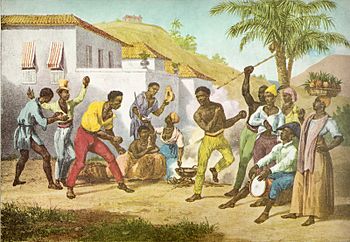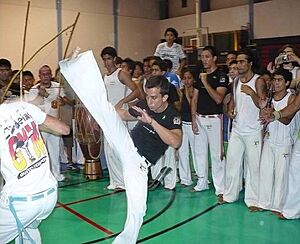Capoeira facts for kids

Capoeira or the Dance of War by Johann Moritz Rugendas, 1825, published in 1835
|
|
| Focus | Kicking, Punching, Slapping, Headbutting, Acrobatics, Leg Sweeps, Knee/Elbow Strikes, Takedowns |
|---|---|
| Country of origin | |
Capoeira is a special mix of martial arts, sport, and popular culture. It was created in Brazil by African people who were enslaved and by native Brazilians. This began around the 16th century. Capoeira was a way for enslaved people to defend themselves and find freedom. For a long time, Capoeira was against the law in Brazil, until the 1930s.
Capoeira uses quick and strong kicks, dodges, and fast counter-attacks. It also includes amazing acrobatics and simple moves to take an opponent down.
Contents
History of Capoeira
Capoeira as a Secret Art
The story of Capoeira likely began when African people were first brought to Brazil as slaves. Portuguese colonists brought many enslaved people from West Africa. Brazil received almost 40% of all enslaved people sent across the Atlantic Ocean.
Capoeira was developed as a secret way for enslaved people to survive. It gave them hope. If they managed to escape, colonial agents would often chase after them. To hide their training, they blended martial arts moves into a dance. With music and rhythmic movements, no one suspected they were practicing fighting skills. As cities grew, more enslaved people were brought in. This helped Capoeira become more well-known. It was taught and practiced among more people. In Rio, the government tried to stop it. They punished people severely for practicing Capoeira.
Capoeira After Slavery Ended
Slavery was ended in 1888. After this, many formerly enslaved people had no homes or jobs. Some people unfairly thought of them as lazy. Capoeira then faced new challenges.
Some people used Capoeira practitioners, called capoeiristas, for protection or fighting. In 1890, the Brazilian government banned Capoeira. Police saw it as a fighting advantage. They did not want certain groups to have this skill. After the ban, anyone caught practicing Capoeira could be arrested. They might even be hurt by the police. Some people still practiced it in hidden places. They had guards to warn them about the police.
By the 1920s, the strict rules against Capoeira started to ease. Mestre Bimba was a strong fighter from Salvador. He felt Capoeira was losing its fighting roots. It was becoming more of a playful show for tourists. So, Mestre Bimba started creating the first organized training method for Capoeira. In 1932, he opened the first Capoeira school. He called it Luta Regional Baiana. This was because using the name "Capoeira" was still illegal. By 1940, Capoeira became legal again.
Capoeira Today
Today, Capoeira is seen as an important symbol of Brazilian culture. It is known all around the world. In 1970, it was taught outside of Brazil for the first time. Capoeira shows are common everywhere. These shows are often like theater and less about fighting.
However, the martial arts part of Capoeira is still there. It is still hidden, just like it was during the time of slavery. Tricky moves are still used by expert dancers. An attack can even look like a friendly gesture. This shows how much skill goes into creating new moves. Capoeira is now a symbol of Brazilian culture. It represents its mix of different cultures. It also stands for resistance against unfairness.
Images for kids
-
Zumbi (1927) by Antônio Parreiras
-
Capoeiristas in a roda (Porto Alegre, Brazil)
-
A capoeira bateria showing three berimbaus a reco- reco and a pandeiro
-
Capoeira at the Marcha da Consciência Negra in São Paulo, Brazil, 2009
See also
 In Spanish: Capoeira para niños
In Spanish: Capoeira para niños











